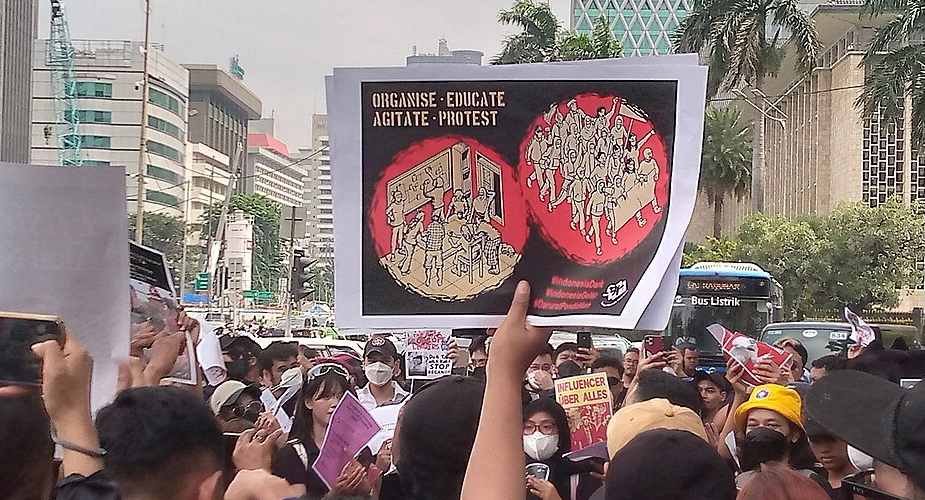Mental health services in Indonesian hospitals
Versi Bh. Indonesia
Mental health services in Indonesian hospitals
Hervita Diatri
I first grasped the importance of quality and safety in health care services 14 years ago when, as a newly graduated psychiatrist, I was assigned to Samosir Island, North Sumatra, for 6 months. There I met an individual in pasung (physical restraint and confinement) for the very first time. Mr. M., who was 56 years old, had been in pasung for 21 years because of his violent behaviour, which was the result of his delusions and hallucinations.
Mr. M. was hospitalised in the Province Mental Hospital (a seven-hour journey by car from his home) for one month, but he relapsed not long after he was released from hospital because he and his family knew little about his illness and the further treatment he required at home. Mr. M.’s sister said that they shackled him because he was in a bad condition and they saw that he had been restrained in the hospital. Mr. M. was not being given enough food and drink, was dirty and smelled of his own urine and excrement. The family, nevertheless, were convinced that they could do the same (or even better) for Mr. M. than the hospital.
That experience reminded me of the education and the training I received when I was placed in hospitals that still made use of confinement. These hospitals had dirty wards and poor living conditions for patients. To prevent them from wandering around and attacking staff, patients were locked in their wards. These patients were hospitalised for a long time and did not have a clear treatment plan. I wondered at the time whether hospitals are really meant to make patients sicker.
The terrible practices I witnessed in psychiatric wards, the attitudes of hospital staff and their approach to patients, and the various management techniques they used on violent patients, were all considered normal. These harsh approaches were formally stipulated in standard operating procedures (SOPs) because psychiatric patients were considered a special group in need of discipline because they were not able to control themselves. Making use of harsh and inhumane measures was deemed necessary to change their behaviour.
Dignified care
I have been lucky to have the opportunity to learn about the different approaches used in other Asian countries and in Australia. This has allowed me to become aware about alternatives that are more humane, dignified, and that encourage recovery. I have come to realise that regulations and standards can be enforced to change the quality of mental health services in Indonesia. This process of learning continued when I had the chance to lead the Committee on Quality and Safety at the Cipto Mangunkusumo Hospital in Jakarta, a teaching hospital for the oldest medical school in Indonesia, the Faculty of Medicine at the University of Indonesia.
Some individuals with mental disorders can be a risk to themselves (by not taking care of themselves, engaging in self harm, or because of suicidal behaviour) and to others. If this is the case, it is very difficult to avoid placing them in a general or a mental hospital to receive treatment. Hospitals tend to be located in large urban areas, which means that families residing in rural areas must go to great lengths to bring their sick family member there. These families do so not only to reduce the risk of dangerous and destructive behaviour, but, most of all, to restore the mental health of their family member so that he or she can be productive again.
The expectations of patients and their families that health services are able to improve mental health, combined with the obligation of all hospitals in Indonesia to be accredited, requires mental health services to continuously improve the quality and safety of the services they provide. This applies both to Indonesia’s 48 mental hospitals (located in 26 provinces) and the 181 general hospitals that also provide mental health services. Poor mental health services can result in patients refusing to return to the hospital after being discharged or to continue their post-hospitalisation treatment program, which adversely affects patients’ relationships with their family. Poor services can also cause patients to develop feelings of worthlessness that can lead to an increased risk of suicide, or to deprivation due to being placed in restrained and isolation (pasung).
Regulating services
Because of the importance of providing high quality mental health care and the adverse effects of failing to provide such care, implementing various regulations and policies that apply at the national and international levels are necessary to provide a sound basis for hospitals to offer good mental health services. These regulations, policies, and other important factors include:
- Living in Hell - Abuses against People with Psychosocial Disabilities in Indonesia (Human Rights Watch, 2016);
- QualityRights document, World Health Organization, 2017;
- Law No. 39 of 1999, concerning Human Rights;
- Law No. 36 of 2009, concerning Health;
- Law No. 25 of 2009, concerning Public Services;
- Law No. 19 of 2011, concerning the Ratification of the Convention on the Rights of Persons with Disabilities;
- Law No. 18 of 2014, concerning Mental Health;
- Law No. 8 of 2016, concerning Individuals with Disabilities;
- Accreditation standards developed by the Joint Commission International (in Care of Patient standards) and the Indonesian Hospital Accreditation Commission (Komisi Akreditasi Rumah Sakit), which specifically include attention to special and vulnerable groups that are at risk of violence, injury, and suicide.
These regulations, documents, and policies outline standards for hospital services, and require hospital administrators to pay attention to the following issues:
- Mental health service facilities should promote recovery and be safe. Although such facilities at times provide custodial services, they should still allow patients to engage in activities they want to partake in, contain spaces and tools to assist them to calm down when required, and should focus on rehabilitation.
- The institutional culture, communication patterns, and the way staff approach patients should respect human rights (including the right to privacy), and involve and empower patients to identify and meet their own needs in accordance with recovery approach principles.
- Staff should be skilled in crisis management, interpersonal approaches that prioritise empathy, have respect for personal dignity and human rights, and have the technical and clinical skills to identify problems and conduct needs-based patient management.
- Collaboration should take place between professionals, patients, families and other caregivers, and consumer groups in planning and evaluating treatment programs.
- The development and implementation of customer satisfaction evaluation systems, incident reporting, and complaints handling, should be encouraged.
- Respect for differences in gender, values, ethnicity, and religion should be nurtured.
Improving the quality of services in accordance with regulations and policies requires good governance that involves both leaders and health professionals. Governance can be applied on two levels, at the hospital level and at an individual level with respect to health workers.

Hospitals
Hospital management can improve the quality of services through the following approaches:
- Develop standard service procedures and measures. Hospital management needs to develop policies, guidelines, standard operating procedures (SOPs) or algorithms that are intended to provide consistent, uniform, and collaborative services by competent personnel. These guidelines should require:
- Procedures for identifying risk (it is strongly recommended to use instruments that are objective, especially for situations that involve restless and violent behaviour, risk of self-injury, or suicide);
- Procedures for documenting the process of collaboration and communication between health care providers;
- Special approval procedures (such as informed consent for risky interventions and treatments, including restraint);
- Monitoring processes that need to be conducted regularly, including defining indicators;
- Qualifications and skills of staff;
- Availability and use of medications and special medical equipment;
- Identification of risks and efforts to mitigate them, e.g. neurological injury and decreased perfusion;
- Quality and safety indicators (including incident reporting system).
- Develop easy access for individuals with disabilities, including individuals with mental disorders. It needs to be taken into account that individuals with mental disorders have a tendency to be uncomfortable when they are in crowded places such as waiting rooms. The same applies to individuals with other disabilities. Specialised services should be provided to them, which includes online registration, fast track access, as well as a special service window.
- Creating a work culture that is oriented towards the safety both of patients and staff so that staff can provide services securely to at-risk populations. Likewise, patients and families should be invited to participate in efforts to improve service quality. Efforts to create such a work culture include:
- Meeting staff needs by providing an adequate number of staff with an adequate level of ability (in terms of clinical skills and performance excellence), and sufficient equipment for staff to carry out their roles and duties optimally;
- Managing incident reports and complaints that aim not to assign blame (no blaming culture) but to encourage improvement and change.
- Involving other stakeholders in efforts to meet service needs and improve service quality. For instance, in peer support group services, and evaluation and service development.
Individual health workers
The main focus of quality and safety development by and for health workers, especially mental health workers, is to build their capacity to:
- Develop an empathic relationship and build mutual trust to establish a therapeutic relationship that is adequate, equitable, and consistent despite staff rotation;
- Develop service planning that involves patients, families, partners, and caregivers to enable them to participate proactively and openly in the process of identifying needs (including concerns and hopes), developing common goals, and work towards terminating medical treatment in order to achieve independence though the process of recovery;
- Foster an atmosphere that enables dynamic, creative, and innovative activities to the benefit of everybody involved;
- Maintain a two-directional approach to communication and education to ensure the consolidation of knowledge, and changes in attitudes and behaviours that encourage independence. This concept is in accordance with the principles of the chronic care model for chronic mental disorders;
- Periodically and openly establish service times in the form of service intervals, times for monitoring and follow-up, including the need for additional time when needed (for example, at critical times) so that a trusting relationship can be established. This condition is, of course, influenced by the amount of clinical and non-clinical work for health workers, especially when the number of staff is insufficient. Time management is important for each individual and is an important factor for accelerating the patient’s recovery process;
- Openly fostering collaboration with various parties including families and consumer organisations to accelerate the recovery process and strengthen the achievement of therapeutic goals;
- Conduct debriefing after each treatment period so that everyone involved can learn and benefit from the process and the achievement of service objectives. The debriefing process is also seen as a way to strengthen the therapeutic relationship, which is necessary to sustain the service process.
It is possible that further measures will have to be implemented to improve the provision of mental health services in health facilities, and especially in hospitals. Various regulations, policies, and directives have already been provided as the basis of change. Changes can be made at the level of management down to the level of individual health workers, but they can also start at the level of individual health workers and then drive change upwards on a larger scale.
The success of efforts to improve the quality of health care and patient safety should not benefit health service providers only. More importantly, they should benefit patients and their families in the recovery process. The desire of health service providers to continuously improve the quality of their services fosters good expectations from all stakeholders. Hope is always a basic and important element in the recovery process.
Hervita Diatri (hervita94@yahoo.com) is a psychiatrist associated with the Faculty of Medicine at the University of Indonesia, and the Cipto Mangunkusumo Hospital. She specialises in community psychiatry and is involved in the accreditation system for hospitals in Indonesia.












